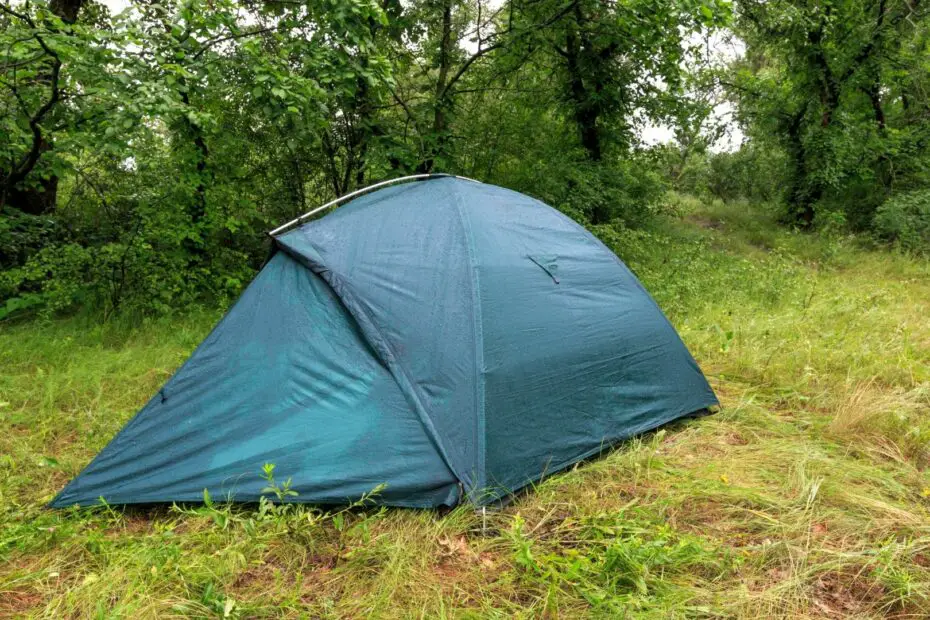When it comes time to pack up your camping gear and head home, the last thing you want to do is pack everything away wet. Packing up a wet tent is a guaranteed way to end up with mold and mildew. Mold and mildew can be a real nuisance when it gets a hold of your tent. Preventing mold and mildew should be your first goal, but there are ways to clean a moldy/mildew covered tent.
Here are some quick tips on how to clean a tent with mold and mildew: Catching mold and mildew early will make cleaning your tent easier. If you catch mold early a combination of sunlight and soap/water (or vinegar/acid wash) should be all you need. A tent that’s been packed away wet and has a mildew smell will need to be deep cleaned with a tent safe detergent and deodorizer. Mild washes will kill the surface mold while preventing further growth, but won’t get rid of the mildew smell.
It doesn’t matter how careful you are with your camping gear. There are times when it’s almost impossible to avoid packing up a wet tent. That won’t be a problem if you remember to set up your tent to dry once you get home, but sometimes life gets in the way. Leaving a wet tent in storage for a few days won’t be a problem, but it won’t take long to end up with mold and mildew.
Don’t worry! A little bit of mold won’t destroy your tent! By following these simple tips, you can make packing up and cleaning your mold and mildew covered tent a breeze.
Table Of Contents
How To Know If Your Tent Has Mold: Identifying Mold and Mildew On A Tent
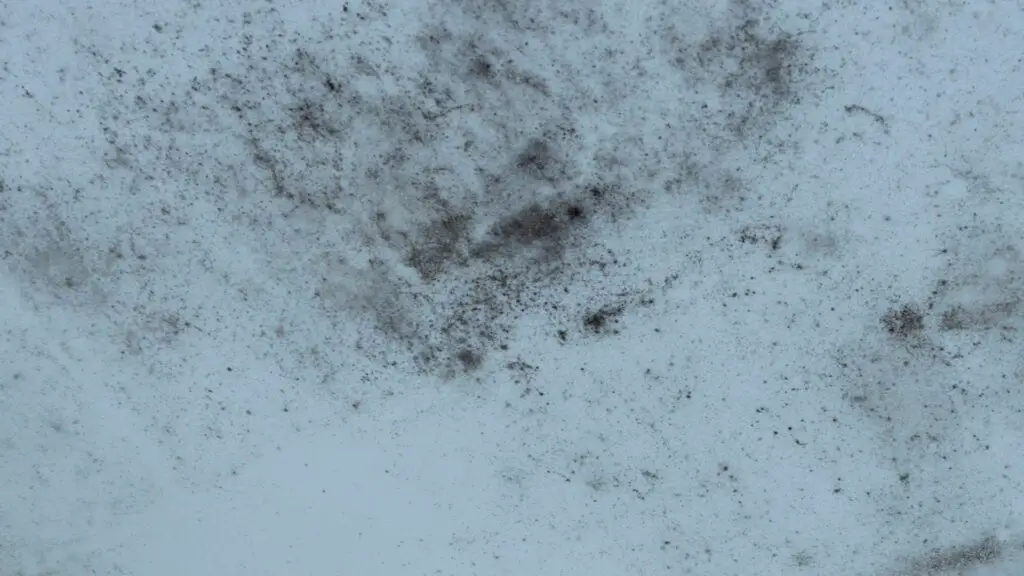
Identifying mold and mildew on a tent is fairly straightforward. If you’ve camped several times, but aren’t sure if your tent is affected with mold, take a look inside and do a thorough inspection. Look for discolored areas on the tent. You can usually brush mud/grime off a tent, but mold won’t be as easy to remove.
Mold has a telltale appearance that’s hard to describe, but it’s different than mud and other grime. It usually starts off as a small blackish specks on the tent fabric, but it could look brown, gray, or green. There will usually be a large central growth with smaller spots branching out from the center.
There will usually be a distinct mold smell as well, but it may not smell if you catch it early. Mold will smell musty and humid due to the moisture needed for mold to grow. You may be able to use soap/water for minor mold growth, but you’ll need an enzymatic deodorizer (my favorite) for serious odors.
General Mold and Mildew Tent Cleaning Tips
If you’re like most people, you probably don’t give your tent much thought until the time comes to use it again. However, taking a little bit of time to clean your tent before storing it away can make a huge difference when it comes time to set it up again. This section will provide you with some basic tips on how to clean and store your tent to prevent mold and mildew growth.
Moisture, Dirt, and general grime prevent the biggest challenge in the short term, but mold/mildew growth can quickly take over with improper storage. The following tips should help keep your tent mold and mildew free. This section is important, but you may want to skip down to the next section where I teach you how to clean a moldy tent if you’re already dealing with mold.
- You can end up with a lot of dirt and grime inside your tent after a long camping trip. A little bit of dirt won’t lead to mold growth, but you still want to shake out loose dirt and vacuum the inside of your tent before putting it into storage. Using a shop vac inside your tent will also help with pooling water, but you still need to give your tent time to dry before packing it away for storage.
- Never pack up a wet tent. If you don’t have enough time to air dry it at your campsite, set it up after you get home to allow it to dry. You may want to check out my post that explains drying a tent in a small apartment if you don’t have a yard/driveway to dry your tent.
- If you’re dealing with minor mold and mildew problems, start by hand washing your tent with soap/water in a bucket, bathtub, or utility sink. Once you’re done cleaning the tent, set it up in your yard, and give it time to dry in the sun. UV rays will kill mold fast, but you may be left with a subtle mildew smell (needs chemical cleaning).
- When mold gets bad, you will need to use a chemical cleaning agent. Vinegar/Acid washes are a cheap way to clean out mold/mildew, but you’re trading a mold smell for vinegar. I recommend using a tent cleaning wash (Revivex Pro Cleaner) paired with an enzymatic deodorizer (Revivex Odor Eliminator) for seriously neglected tents. You will need to soak the tent in a cleaning bath for 24 hours and then use the deodorizer to get rid of stubborn odors.
- Once your done cleaning the tent with a mold/mildew wash, you need to set it up in your yard to dry. Deep cleaning a tent will damage the water repellent coating so you definitely need to reapply some kind of waterproofing spray. This is the perfect time to wash your tent down with a tent cleaning spray (my favorite) and spray it down with waterproofing (Nikwax Tent Solarproof and Waterproofing). You may be able to skip the cleaning spray, but always use a DWR coating after enzymatic cleaning.
How to Clean a Tent with Mold and Mildew
Are you a camper? Do you know how to clean a tent with mold and mildew? If not, don’t worry – this guide will teach you everything you need to know! Mold and mildew can be a real nuisance, but it can be easily cleaned up with the right supplies and some elbow grease. So gather your supplies and get started!
What Do I Need To Clean Mold and Mildew Off A Tent
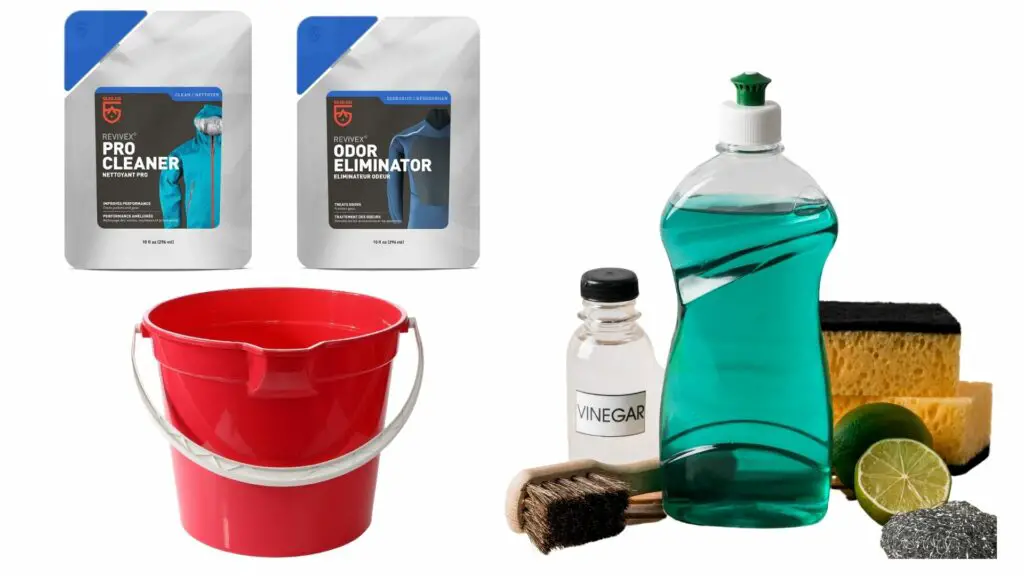
- Bucket, Bathtub, or Wash Basin: Spot cleaning a tent with tent washing sprays won’t be enough to get rid of stubborn mold/mildew odors. You will need a large container to wash and soak your tent.
- Soap and Water: A wet tent that’s been sitting in the trunk of your car for a few days probably won’t need deep cleaning. Washing your tent with a mild dish soap and water should be able to get the job done. Enzymatic cleaners and deodorizers are expensive so start with soap/water and move on from there.
- Tent Washing Detergents: Serious mold issues will require some kind of technical outdoor detergent. Nikwax Tech Wash and Revivex Pro Cleaner are the two most popular brands. They’re designed to be used on synthetic gear without damaging the Durable Water Repellent (DWR) coating.
- Enzymatic Based Deodorizers: A seriously smelly tent will require some kind of enzymatic deodorizer. Revivex Odor Eliminator is the gold standard for removing mold and mildew odors. Soaking your tent for in an enzymatic cleaner is the only guaranteed way to eliminate mildew smells.
- Spray On Mold and Mildew Cleaners (Optional): Spot treatment sprays will only work if you’re dealing with a small amount of mold. There are lots of different mold/mildew sprays that will work, but it can be hard to find one that’s gentle enough to use on a tent. Test the spray on a discrete area of the tent and never use a bleach based cleaner.
- Vinegar and Lemon Baths (Optional): Vinegar and Lemon baths work just like an enzymatic cleaner, but you’re trading the mildew smell for vinegar. Some people swear by this method since it’s cheaper, but I’ve never been satisfied with the results. There will always be a subtle vinegar smell leftover on hot/humid days.
5 Easy Ways To Clean Mold and Mildew from a Tent
There are 5 simple ways to remove mold and mildew from a tent. The cleaning method you choose will depend on how bad the mold is. I’ve listed the methods in order from least to most effective, but here’s a brief rundown explaining which method you should choose.
- Soap and Water Method: Use soap and water to clean mild issues. If you catch mold growth within the first couple weeks this should be all you need.
- Vinegar and Lemon Juice: This method will work on mild odors, but it’s not strong enough for a tent that’s been left in damp storage for years. I don’t like this method, because it leaves behind a telltale vinegar smell. It’s better than breathing in mold, but enzymatic washes aren’t that expensive so I’d skip this step.
- Spray On Spot Treatments: Spray on cleaning may or may not work depending on how much mold you’re dealing with. Just be careful, because they usually have bleach and other ingredients that could damage your tent.
- Tent Washing Detergents: This is the easiest cleaning method and best cleaning method for serious mold problems. It will clean the entire tent and kill all the mold spores on your tent.
- Enzymatic Deodorizers: Enzymatic deodorizers don’t technically kill/clean mold, but it’s the only guaranteed way to get rid of mildew odors.
A Quick Note: For any of these cleaning methods, you should spot clean a discrete area of the tent first. Products that are designed for technical fabrics shouldn’t cause issues, but other cleaning products could stain or damage your tent.
1) Soap and Water Method
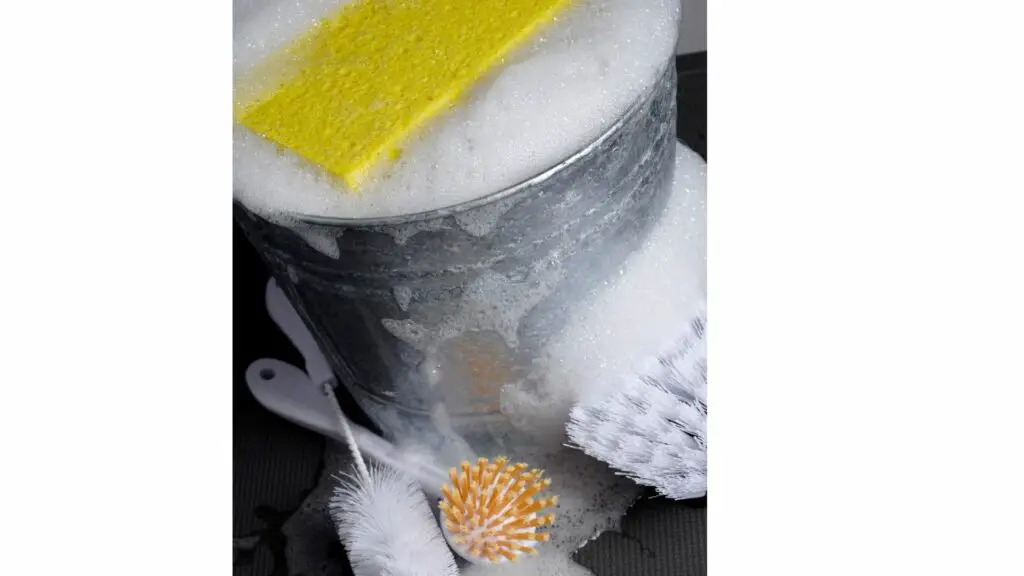
Cleaning mold out of a tent with soap and water is fairly straightforward. Just set up the tent and start scrubbing wherever you see mold. This method will only work on minor mold growth that’s formed over the last couple of months.
- Pitch Your Tent: Pitch your tent in a convenient location with close access to your garden hose. You don’t want to release mold spores inside your home, so it needs to be cleaned outside. Plus it will be easier to dry off a tent that’s exposed to direct sunlight.
- Brush Off Mold, Dirt, and Grime: Take a soft bristled brush and dry brush any areas of the tent with surface discoloration. This should loosen up the mold and get rid of easy to remove dirt.
- Fill A Bucket With Warm Water and Non Detergent Soap: Fill up a bucket with warm water and spray a mild dish detergent into the mixture. This isn’t entirely necessary, but try to avoid fragrant soaps that will attract insects.
- Soak Your Brush and Spot Clean The Mold or Mildew: Use your brush to spot clean mold/mildew spots on the tent fabric. Be careful when brushing your tent, because it may take a lot of scrubbing to remove stubborn stains. You can easily tear a hole in older tents if you’re using a stiff bristled brush.
- May Need To Soak The Tent In A Tub: If you can’t get all of the mold off your tent, you may need to soak it in a bucket of soap/water for 24 hours. You can try to do this step without adding tent cleaning detergents, but detergents may be necessary for stubborn mold and mildew stains. I always add 2 fl oz of Revivex Pro Cleaner, because I don’t want to waste another day dealing with mold.
- Consider Using A Waterproof Cleaning Spray: This is the perfect time to spray down your tent with a waterproof cleaning spray (DWR Coating). You’ve already done 90% of the work cleaning off the tent, so spraying the tent down with a DWR spray won’t take more than a minute or two. I use Nikwax Solarproof on all my gear, but Kiwi Camp Dry is a slightly cheaper option (slightly smaller bottle).
- Hose Off Your Tent: Once you’re satisfied with the mold/mildew removal, hose off the inside/outside of your tent. This will hopefully get rid of all the dirt, mold, grime, and soap suds.
- Give Your Tent 24 Hours To Dry: It rarely takes longer than 2-3 hours to dry a tent in direct sunlight, but I recommend giving your tent 24 hours to completely dry. Just make sure you give yourself a few hours in the morning so the morning dew has time to dry.
2) Deep Cleaning Detergent Method (Best Cleaning Option)
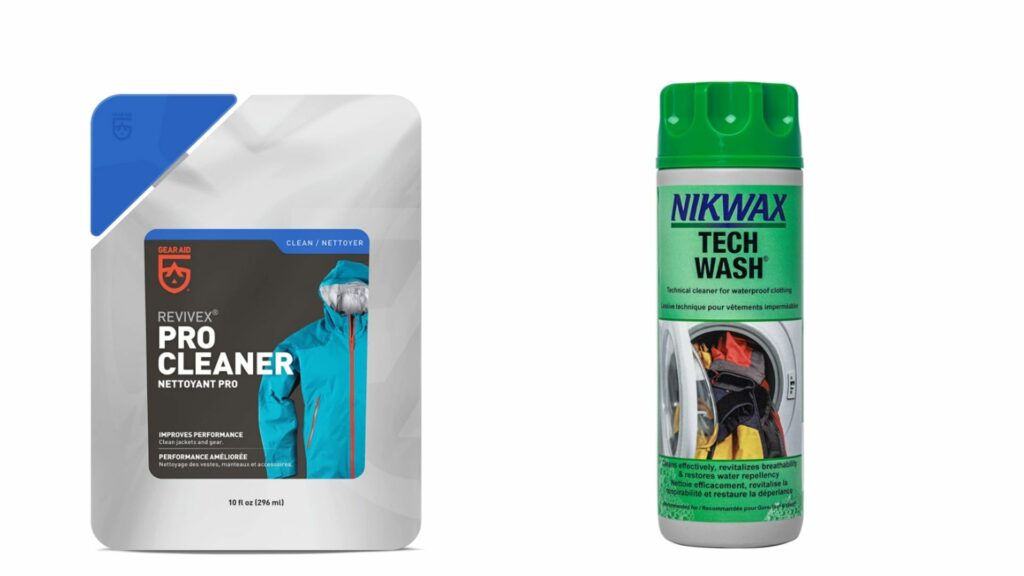
This should be your primary cleaning method if you’re trying to clean mold on an expensive tent. It’s designed for tent fabrics, won’t damage waterproof coatings, and a bottle of Revivex Pro Cleaner isn’t that expensive. Plus it will save a lot of time since you can skip all of the gentle cleaning methods listed above.
- Spot Clean With Soap and Water: Spot clean dirty areas with a sponge and soap and water.
- Fill A Tube With Warm Water and Revivex Pro Cleaner: Fill up a small tub with warm water and add 2 fl oz of Revivex Pro Cleaner
- Soak Your Tent In The Tub And Hand Wash: Submerge your tent in the cleaner and hand wash the outer fabrics
- Don’t Damage The DWR Coating: Don’t scrub the underside of your rainfly since it can damage the waterproof coating. If that’s where the mold/mildew stains are located, you will need to apply a DWR spray (my favorite) once your finished cleaning the tent.
- Rinse With Warm Water: Rinse with water until the soapy residue is gone and save the mixture for the following step.
- Pitch Your Tent And Spot Clean: Pitch the tent outside and check to see if you missed any spots of mold or mildew. Use a soft bristle scrub brush to spot clean problem areas.
- Dry The Tent and Check For Odors: Give your tent at least 6 hours to dry and check to see if you’ve removed mold and mildew odors. If there’s a lingering mildew odor you will need to soak the tent in an enzymatic deodorizer.
3) Enzymatic Deodorizers For Removing Mold, Mildew and Tent Odors
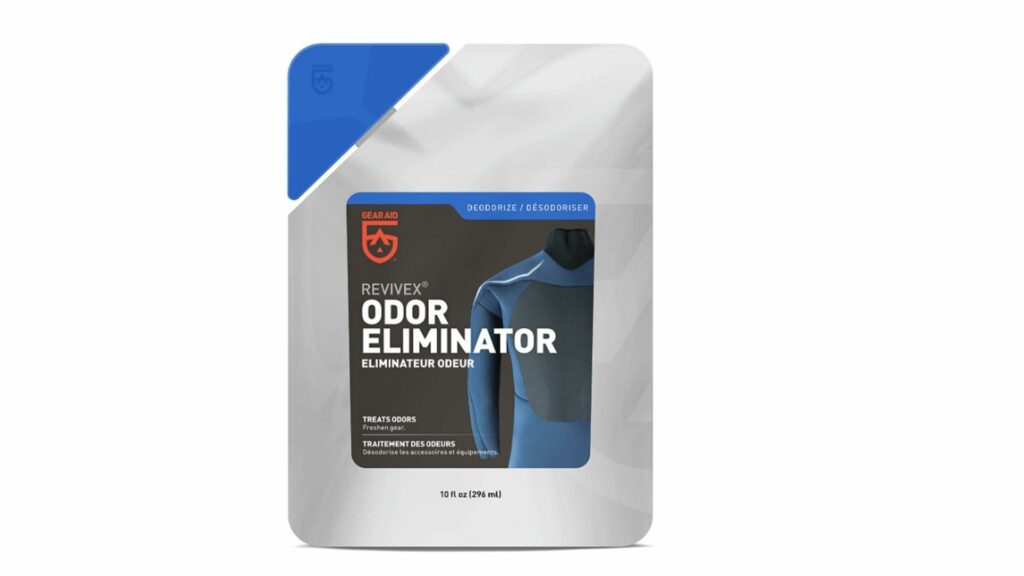
You will need to use an enzymatic cleaner to deodorize your tent if there’s a lingering mildew odor. I’ve tried every possible cleaning method and this is the only guaranteed way to get rid of stubborn mold and mildew odors on a tent.
Revivex Odor Eliminator is the only enzymatic cleaner that’s designed to be used on a tent. I’ve heard of people using pet urine cleaners on tents, but it’s hard to say if they’ll damage your tent. It’s worth spending the extra money on Revivex to avoid accidentally damaging your tent.
- Place Your Tent In A Small Tub: Put your tent in a small tub and spread it out across the bottom.
- Add Hot Water To The Tub: Fill a tub with just enough water to submerge the tent. A small bottle of Revivex can only handle 2 gallons of water. So try not to use more water than you absolutely need.
- Add Revivex Odor Eliminator: Add 1 fl oz of Revivex Odor Eliminator for every gallon of water. I recommend going with the 10 oz pouch of Revivex since it’s not that much more expensive than the 2oz version.
- Open Your Zippers: Unzip all the zippers and open up your tent flaps. The waterproof coating will create air pockets if you don’t open up all the zippers.
- Saturate The Tent For 5 Minutes: Next, soak the tent in the Odor Eliminator mixture for a maximum of 5 minutes to saturate the tent with microbes
- Don’t Rinse Off The Tent: Rinsing off the tent will remove the deodorizing agents. It will take 2-3 hours to completely eliminate stubborn mold odors.
- Give Your Tent Time To Dry: Trying to dry your tent in the soaking tub will take multiple days. So I recommend pitching your tent outside so that it will dry faster.
- Pack Up Your Tent: This should have completely eliminated any mildew smell so it’s time to pack up your tent. Make sure it’s completely dry and store your tent in a moisture controlled environment. You don’t want mold to start growing again once your tent’s in storage.
4) Vinegar and Lemon Methods (A Cheap/Easy Option)
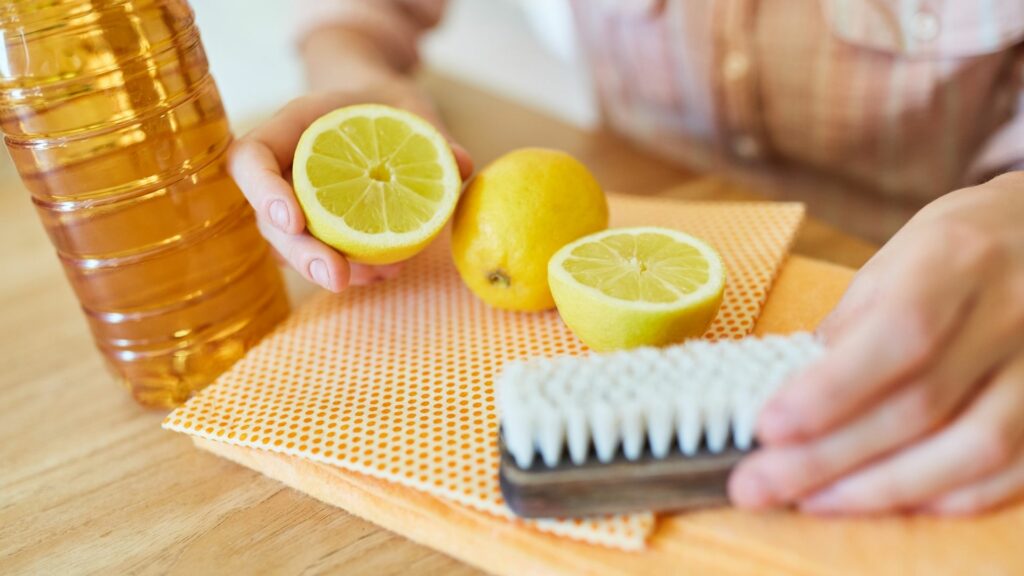
I have a love/hate relationship with the vinegar and lemon cleaning method. It gets rid of mold and mildew, but you’re left with a subtle vinegar smell. This method won’t get rid of serious mildew odors, but it should help some.
You can also try this method by substituting the vinegar with with lemon and salt. This won’t be as effective at eliminating mildew odors, but you won’t be left with a vinegar smell. All you need is a gallon of hot water, a cup of lemon juice, and a cup of salt. Follow the same instructions as the vinegar method and move onto other cleaning methods if this doesn’t work.
- Mix Water And Vinegar: Mix a cup of warm water and quarter cup of vinegar in a spray bottle.
- Spray The Mixture On The Mold and Mildew: Spray down the affected area with the vinegar solution.
- Let The Solution Rest: Give the solution 10 minutes to soak into the tent fabric.
- Scrub With A Soft Bristled Brush: Start scrubbing with a soft bristled brush until you’ve removed all the mold.
- Give The Tent Time To Dry: Give the tent 2-3 hours to dry. You’re not completely soaking the tent with this method so it shouldn’t take long to dry in direct sunlight.
5) Spray-On Spot Treatment Methods (Last Resort)
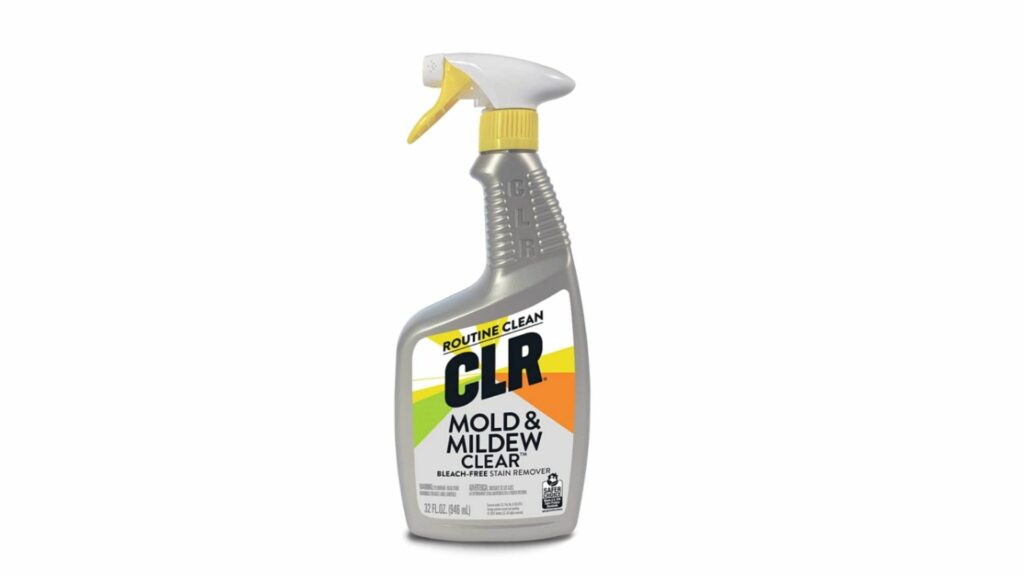
Whether or not you should try this method depends on your tent. Using this method only makes sense if you’re trying to clean a cheap tent. It’s not worth spending $10 on tent detergent if the entire tent costs $30. This can seriously damage a tent so it should only be used as a last ditch effort to avoid throwing away a cheap tent.
Head down to your local Walmart or any grocery store and pick up a bottle of mold and mildew cleaner. Try to find a cleaner that doesn’t have bleach or any other harsh cleaners. CLR Mold and Mildew Clear is a great choice since it’s fairly mild and bleach-free. You can always use it to clean up around the house if it doesn’t work on your tent.
Start by scrubbing with a soap/water solution and spray down the mold with your mold/mildew cleaner. Give the cleaner 5 minutes to soak into the fabric and start scrubbing with a soft bristle brush. Hose off the cleaning solution and give your tent a few hours to dry.
Properly Store Your Tent To Prevent Future Mold and Mildew Growth
Make sure you properly store your tent to prevent future mold and mildew growth. Your tent needs to be completely dry before packing it up and putting it into storage.
- Dry Your Tent: Pitch your tent outside and give it plenty of time to dry. Don’t forget to check the bottom of your tent for moisture that it could have picked up off the grass.
- Store Your Tent In A Loose Breathable Bag: The stuff sack that came with your tent is great for backpacking, but it’s a poor choice for long term storage. Tent fabrics need to relax and breathe. Store your tent in an old pillowcase or small mesh bag so that it can dry out in storage.
- Keep Your Tent In A Cool Dry Place: When searching for a place to store your tent, try to find a cool dry place. Avoid damp locations like a basement, attic or car trunk. A temperature controlled gear closet or garage shelf are both good options.
